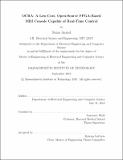OCRA : a low-cost, open-source FPGA-based MRI console capable of real-time control
Author(s)
Anand, Suma(Suma M.)
Download1098041021-MIT.pdf (10.64Mb)
Alternative title
Open-source Console for Real-time Acquisition
Low-cost, open-source FPGA-based MRI console capable of real-time control
Other Contributors
Massachusetts Institute of Technology. Department of Electrical Engineering and Computer Science.
Advisor
Lawrence Wald.
Terms of use
Metadata
Show full item recordAbstract
This thesis describes the development of a low-cost, open source, FPGA-based con- sole (hardware controller) for an educational MRI scanner. The console is known as OCRA: Open-source Console for Real-time Acquisition. Conventional MRI con- soles may be high cost, closed-source, and inflexible, in that it is not possible to change acquisition parameters once the scan is started. In contrast, OCRA is under $500, open-source, and capable of real-time updates to the acquisition. In particular, the console can update the sequence of excitations played out by the MRI console, known as the pulse sequence, in real time, a feature unique to this console. For hard- ware, OCRA uses the Red Pitaya, a commercially available Zync SoC board with a dual-core ARM CPU and Xilinx FPGA. The functionality of the console has been demonstrated on the MGH/MIT Tabletop scanners [2] developed in 2014 and used in MIT courses to teach students about signal processing. The major contributions of this thesis are the software programs for controlling and programming the console. They are: a Python-based Graphical User Interface (GUI) or client for controlling the acquisition and manipulating acquired data, a C-based server program for setting the memory of the sequence, and a low-level programming language for developing custom pulse sequences. The software is demonstrated in a basic example of real-time motion correction. In future work, OCRA can be extended to other MRI systems, particularly low-cost and custom built systems. Additionally, the console could be made more user-friendly through a higher-level programming language for developing pulse sequences, which would be built on top of the low-level language developed in this work. Finally, the real-time updating capabilities can be developed further, to correct artifacts (e.g. temperature-based drift) and even to develop a completely automated, data-driven acquisition that builds itself based on the acquired data.
Description
This electronic version was submitted by the student author. The certified thesis is available in the Institute Archives and Special Collections. Thesis: M. Eng., Massachusetts Institute of Technology, Department of Electrical Engineering and Computer Science, 2018 Cataloged from student-submitted PDF version of thesis. Includes bibliographical references (pages 85-86).
Date issued
2018Department
Massachusetts Institute of Technology. Department of Electrical Engineering and Computer SciencePublisher
Massachusetts Institute of Technology
Keywords
Electrical Engineering and Computer Science.